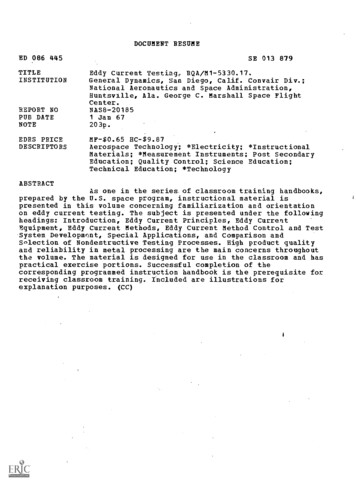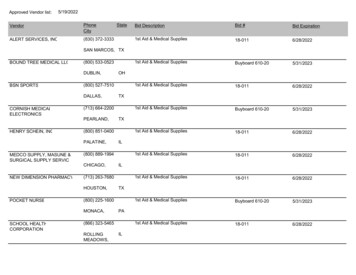
Transcription
DOCUMENT RESUMEED 086 445TITLEINSTITUTIONREPORT NOPUB DATENOTEEDRS PRICEDESCRIPTORSSE 013 879Eddy Current Testing, RQA/M1-5330.17.General Dynamics, San Diego, Calif. Convair Div.;National Aeronautics and Space Administration,Huntsville, Ala. George C. Marshall Space FlightCenter.NAS8-201851 Jan 67203p.MF- 0.65 HC- 9.87Aerospace Technology; *Electricity; *InstructionalMaterials; *Measurement Instruments; Post SecondaryEducation; Quality Control; Science Education;Technical Education; *TechnologyABSTRACTAs one in the series of classroom training handbooks,prepared by the U.S. space program, instructional material ispresented in this volume concerning familiarization and orientationon eddy current testing. The subject is presented under the followingheadings: Introduction, Eddy Current Principles, Eddy CurrentEquipment, Eddy Current Methods, Eddy Current Method Control and TestSystem Development, Special Applications, and Comparison andSelection of Nondestructive Testing Processes. High product qualityand reliability in metal processing are the main concerns throughoutthe volume. The material is designed for use in the classroom and haspractical exercise portions. Successful completion of thecorresponding programmed instruction handbook is the prerequisite forreceiving classroom training. Included are illustrations forexplanation purposes. (CC)
FILMED FROM BEST AVAILABLE COPYJonuaryiJI1967U S DEPARTMENT OF HEALTH,EDUCATION 8. WELFARENATIONAL INSTITUTE OFEDUCATIONQUAf,ITY ANDRELIABILITY ASSURANCELABORATORYTHIS DOCUMENT HAS BEEN RE- PRODUCED EXACTLY AS RECEIVED FROMTHE PERSON OR ORGANIZATIONRIGINAT1NG IT POINTS OF VIEW OR OP'NONSSTATED DO NOT NECESSARILY REPRESENT OFFICIAL NATIONAL INSTITUTE orEDUCATION POSITION OR PrL ICYEDDY CURRENT TESTINGRQA/M 1-5330 .17NUAISVILIA, ALMA*NATIONAL AERONAUTICS AND SPACE ADMINISTRATIONFccm 1262 (September 1961)
5330. 17PREFACEClassroom Training Handbook - Eddy Current Testing (5330. 17) is one of a series oftraining handbooks designed for use in the classroom and practical exercise portionsof Nondestructive Testing. It is intended that this handbook be used in the instructionof those persons who have successfully completed Programmed Instruction Handbook Eddy Current Testing (5330. 12, Vols.Although formal classroom training is not scheduled at the present time, this handbookcontains material that is beneficial to personnel engaged in Nondestructive Testing.NASA's programs involve tightly scheduled procurement of only small quantities ofspace vehicles and ground support equipment, requiring the extreme in reliability forthe first as well as later models. The failure of one article could result in missionfailure. This requirement for complete reliability necessitates a thoroughly disciplined approach to Nondestructive Testing.A major share of the responsibility for assuring such high levels of reliability lieswith NASA, other Government agencies, and contractor Nondestructive Testing personnel. These are the people who conduct or monitor the tests that ultimately confirmor reject each piece of hardware before it is committed to its mission. There is noroom for error no chance for reexamination. The decision must bei rightunquestionably the first time.General technical questions concerning this publication should be referred to theGeorge C. Marshall Space Flight Center, Quality and Reliability Assurance Laboratory, Huntsville, Alabama 35812.The receipient of this handbook is encouraged to submit recommendations for updatingand comments for correction of errors in this initial compilation to George C. MarshallSpace Flight 'enter, Quality and Reliability Assurance Laboratory (R-QUAL-OT),Huntsville, Alabama 35812.
5330.17ACKNOWLEDGMENTSThis handbook was prepared by the Convair Division of General Dynamics Corporationunder NASA Contract NAS8-20185. Assistance in the form of process data, technicalreviews, and technical advice was provided by a great many companies and individuals.The following list is an attempt to acknowledge this assistance and to express ourgratitude for the high degree of interest exhibited by the firms, their representatives,and other individuals who, in many cases, gave considerable time and effort to theproject.Aerojet-General Corp.; Automation Industries, Inc., Sperry Products Division;AVCO Corporation; The Boeing Company; The Budd Co., Instruments Division;Douglas Aircraft Co., Inc.; Dr. Foerster Institute; General Electric Co.; GrummanAircraft; Mr. John Hall; Mr. Richard Hochschield, Microwave Instruments Co.;Mr. H. L. Libby, Lockheed Aircraft Corp.; Magnafltrx Corp.; Magnetic AnalysisCorporation; The Martin Co. (Denver); McDonnell Aircraft Corp.; North AmericanAviation, Inc.; Pacific Northwest Laboratories, Batelle Memorial Institute; RohrCorporation; SoW.hwest Research Institute; St. Louis Testing Laboratories, Inc.ii
5330.17CLASSROOM TRAINING HANDBOOKEDDY CURRENT TESTINGCHAPTER 1INTRODUCTIONCHAPTER 2EDDY CURRENT PRINCIPLESCHAPTER 3EDDY CURRENT EQUIPMENTCHAPTER 4EDDY CURRENT METHODSCHAPTER 5EDDY CURRENT METHOD CONTROL ANDTEST SYSTEM DEVELOPMENTCHAPTER 6SPECIAL APPLICATIONSCHAPTER 7COMPARISON AND SELECTION OF NDT PROCESSESiii
5330.17CHAPTER 1: INTRODUCTIONTABLE OF PTION OF CONTENTS1031041052.LocatorsINDUSTRIAL APPLICATIONS OF EDDY CURRENT TESTINGBASIC EDDY CURRENT TESTINGADVANTAGES AND LIMITATIONS OF EDDY ntAdvantagesLimitationsDESTRUCTIVE AND NONDESTRUCTIVE TESTING1.Destructive Testing2.Nondestructive TestingTESTING PHILOSOPHYPERSONNELTESTING CRITERIATEST PROCEDURESTEST OBJECTIVESSAFETY 1-51-51-51-51-51-61-6
5330.17CHAPTER h INTRODUCTION100GENERALThe complexity and limited procurement on NASA programs and projectsdictates a total reliability approach to the task of designing, developing, testing,and producing space vehicles and associated ground equipment. The techniques ofnondestructive testing (NDT) are a significant factor in achieving the objective ofmaximum reliability.1.101PURPOSEThis handbook provides a firaciamental knowledge of eddy current principles. Theinformation contained herein will enable NDT quality assurance and test personnelto evaluate test requirements; verify that the proper test technique or combinationof techniques are being used to assure the quality of the articles and materials undertest; interpret the results of eddy current tests; and recognize those areas of testresults that require either rete.t or further evaluation.1021.2.DESCRIPTION OF CONTENTSARRANGEMENTa.Chapter 1:Introduction, advantages and limitations, testing, personnel,and safety considerationsb.Chapter 2:Eddy current principles and basic electrical conceptsrelated to eddy current testingc.Chapter 3:Eddy current equipment, coils (absolute differential), typesof presentations - meter, cathode ray, tube strip recorderd.Chapter 4:Eddy current techniques, conductivity, discontinuity, andcoating thickness testing; phase and modulation analysis;and applications.e.Chapter 5:Method control, low conduction materials, conductive liquidsand gasesf.Chapter 6:Special applications, dimensions and conductivity measurements, edge discontinuity detectiong.Chapter 7:Comparison and selection of NDT processes as related tothe detection of various discontinuities.LOCATORSThe first page of each chapter consists of a table of contents for the chapter. Majorparagraphs, figures, and tables are listed in each table of contents.1-3
5330. 17103INDUSTRIAL APPLICATIONS OF EDDY CURRENT TESTINGEddy current testing can be applied to cylinders, tubing, sheets and coatings, andprovides a means for measuring conductivity, detecting discontinuities, and determining the thickness of coatifigs or plating on articles. Since a co.itin-aous indication is apart of the basic testing system, .automatic production testing is particularly feasible.Test and indication are, for all practical purposes, simultaneous.104BASIC EDDY CURRENT TESTINGEddy current testing is the process of inducing small electrical currents into a conductive article and observing the interaction between the article and the currents. Anumber of factors within the article will affect the flow of these eddy currents andmeans exist for relating test indications to these factors.1051.2.1061.ADVANTAGES AND LIMITATIONS OF EDDY CURRENT TESTINGADVANTAGESa.Accurate measurement of conductivityb.Immediate indicationc.High speed testingd.Detection of small discontinuity arease.Non contacting.(e. g.,0. 00006 square inches)LIMITATIONSa.Specific nature of discontinuities are not clearly identifiedb.Depth of penetration restricts testing to depths of less than one quarterinch in standard casesc.Testing of ferro-magnetic metals is sometimes difficultd.A permanent record of discontinuity is often not available.DESTRUCTIVE AND NONDESTRUCTIVE TESTINGDESTRUCTIVE TESTINGDestructive testing as compared to nondestructive testing requires that the testarticle be loaded and/or sectioned to destruction so as to verify and/or establishengineering design requirements.
5330,17Often such a procedure is used to correlate various NDT discontinuities (size andlocation) to structural or service life of an article.2.NONDESTRUCTIVE TESTINGFive methods of nondestructive testing are currently in common use: magnetic particle, liquid penetrant, eddy current, ultrasonic, and radiographic. Each method haspeculiar capabilities and limitations qualifying it for specific uses. It is necessary toanalyze each test article and determine which test method or NDT process will bestobtain the desired results. In many instances more than one method may be required.For each article requiring testing, the determination of the proper test method, ormethods, is made by qualified NDT personnel.107TESTING PHILOSOPHYThe basic reason for nondestructive testing is the ability to test, without damage, allcomponents in production, and thereby assure maximum reliability. Specifically, thespace vehicle, with its thousands of square feet of thin metal sheet, thousands of feetof large and small diameter tubing, and many small articles must be checked for complete reliability. With qualified personnel and test equipment, the reliability of allcomponents can be assured. Test standards are high and the test equipment andpersonnel must he capable of producing results that measure up to these standards.108PERSONNELIt is imperative that personnel responsible for eddy current testing be trained andhighly qualified with a technical understanding of the test equipment, the item undertest (article), and the test procedures. To make optimum use of eddy current testing,NDT personnel conducting tests must keep abreast of new developments.109TESTING CRITERIAEddy current testing should be performed using approved written procedures authorized by the using agency. Test and quality assurance personnel should be governedby the using agency with specific instructions and approved test data.110TEST PROCEDURESApproved procedures for eddy current testing are formulated from analysis of thetest article, review of past history, experience on like or similar articles, andinformation available concerning similar article discontinuities. It is the responsibility of personnel conducting or checking a test to insure that test procedures areadequately performed and that the test objective is accomplished.1-5
5330. 17111TEST OBJECTIVEThe objective of eddy current testing is to:a.Insure product reliability.b.Provide test data that can be evaluated against an acceptable referencestandard.c.Identify and reject unacceptable articles.d.Evaluate test results to determine the source and cause of article discontinuities.e.Revaluate test standards and procedures for continued product improvement.112SAFETY CONSIDERATIONSEddy current testing uses alternating current sources; therefore, normal electricalprecautions should be observed, Eddy current testing does not present unique safetyhazards to personnel,
5:130.17CHAPTER 2: EDDY CURRENT PRINCIPLESTABLE OF CONTENTSParagraph200Page.GENERAL1.2.3.201FACTORS .AFFECTING EDDY CURRENT TESTING1.2022.3.4.5.GeneralEddy r4rrents Induced by Encircling CoilF Ily Currents Induced by Inside CoilEddy Currents Induced by Surface CoilEddy Currents Traduced by Gap ProbedDepth of Eddy Current Penetration6.TEST COILS INFORMATION ility3.4.Magnetic CouplingDIRECTION AND DISTRIBMION OF EDDY CURRENT INARTICLE1.203Definition of Eddy CurrentSystem - Eddy CurrentSystems ElementsGeneralElectromagnetic WaveImpedance ChangePhase Change3.4.PHASE ClIANGE PRODUCED BY ARTICLE1.2.3.4.5.Figure 2-1Figure 2-2Figure 2-8Figure 2-4Figure 2-5Figure 2-6Figure 2-7Figure 2-8Figure 2-9Figure 2-10Figure 2-11GeneralConductivity, Permeability, and Dimension VariablesConducLivity Phase ChangePermeability and Dimension Phase ChangeRelationship Between Article Phase ChangesEddy Currents in ArticleEddy Current SystemElements of Eddy Current SystemPure Element Lattice StructureImpurity in Lattice AtomHeat Treatment Affect on ElementsLattice DistortionLattice SwellingDistortion of Eddy Current Wave PatternMagnetic 32-142-152-1
5330.17TABLE OF CONTENTS (CONT)PageParagraphFigure 2-12Figure 2-13Figure 2-14Figure 2-15Figure 2-16Figure 2-17Figure 2-18Figure 2-19Figure 2-20Figure 2-21Figure 2-22Figure 2-23Figure 2-24Figure 2-25Figure 2-26Figure 2-27Figure 2-28Figure 2-29Figure 2-30Figure 2-31Figure 2-32Figure 2-33Figure 2-34Figure 2-35Figure 2-36Figure 2-37Figure 2-38Figure 2-39Figure 2-40Figure 2-41Figure 2-42Figure 2-43Figure 2-44Figure 2-45Figure 2-46Figure 2-47Figure 2-48Flux DensityUnequal Changes in Flux DensitySaturation Magnetic PointResidual ive ForceHysteresis LoopCoils Magnetizing ForceFlux Density NonmagneticFlux Density MagneticResidual Magnetism - Magnetic and NonmagneticMaterialsMagnetic Field in a Straight WireMagnetic Field in a LoopMagnetic Field in a SolenoidMagnetic Field Within Solenoid With Iron CoreSurface Coil Lift-OffNon-Conductive SurfaceFill-FactorFall-OffShieldingEnd EffectDirection of Eddy Current Paths in CylindeT4Eddy Current Induced by Gap ProbeEddy Current Testing System Electrical *ValuesImpedanceComparison. of Test Article to Standard ReferenceCoil's Magnetic FieldAlternating Output VoltageIn PhaseOut of PhaseInductance Caused by Magnetic FieldCoil Inductance/Inductive ReactanceImpedance/Inductive ReactanceCoils Impedance and Voltage PlanesCurrent/Voltage Relationship in Secondary CoilVoltage Relationship in CoilVoltage Output of External Comparison ArrangementConductivity, Permeability and Dimension -382-392-402-402-422-422-43
5330. 17TABLE OF CON TENTS (CONT)ParagraphFigure 2-49PageFigure 2-50Family of Curves Showing Variability WithinMagnetic ArticleConductivity/Permeability2-442-45Table 2-1Typical Depth of Penetration2-32
5330.17CHAPTER 2:200EDDY CURRENT PRINCIPLESGENERALThis chapter presents basic principles related to eddy current techniques, interpretations, and applications. The depth of presentation is oriented to the eddy current NDTspecialists, not to the personnel responsible for the design of initial eddy current testing systems. The reader should realize that each test situation is a separate eddycurrent design problem. This problem is solved by designing an eddy current testingsystem for the particular test situation. Once the system is designed and testing procedures are established, the task becomes one of performing eddy current testing inaccordance with the established and approved procedures. This is the task of the NDT1.DEFINITION OF EDDY CURRENTSAny eddy current is defined as a circulating electrical current induced in a conductingarticle by an alternating magnetic field. As the magnetic field alternates, so does theeddy current (reverses). This eddy current flow is limited to the area of the inducingmagnetic field. Figure 2-1 illustrates a typical eddy current induced in an articleby a test coil on the s'irface of the article. Note that eddy currents travel parallelto the surface.NOTEWHEN A GENERATOR'SELECTRICAL CURRENTREVERSES ITS DIRECTION, THE DIRECTIONOF THE EDDY CURRENTSGENERATORELECTRICAL CURRENTWILL ALSO REVERSE.TEST COILARTICLEEDDYCURRENTSFigure 2-1.Eddy Currents in Article
5330.172.SYSTEM - EDDY CURRENTAs shown in Figure 2-2, eddy current testing is a nondestructive testing system whichapplies a testing medium to an article and through the article's reaction to the testingmedium obtains aa output indication.TESTING MEDIUMTESTINGSYSTEMARTICLEREACTIONINDICATIONFigure 2-2.3.Eddy Current SystemSYSTEMS ELEMENTSThe basic elements of such a system, as shown in Figure 2 -3, are. a test coil, agenerator, and an indicator.,GENERATORII III IITEST COIL WITHMAGNETIC FIELDkARTICLEINDICATORJFigure 2-3.2-6Elements of Eddy Current System
5330.17Since the NDT specialist is interested primarily in the teat coil application and theoutput indications, we will examine these elements more closely.a.b.2011.The basic working element of the eddy current sensing systemis a test coil. Some common test coil terms are:Test Coil.As an alternating current flows through the test coil,a corresponding electromagnetic field is genera'ed. This alternatingmagnetic field induces a flow of eddy currents Vrithin the article.(1)Magnetic field.(2)Absolute coil.(3)Differential coil. The term applied to the use of two coils (usually),that electrically oppose each other. Bulk characteristics of the article will cancel out, but small defects will show as a difference betweencoils.(4)Shape.(5)Surface coil or probe. The term used for those coils designed to beapplied on the surface of the article.(6)Inside diameter coil. The term used for those coils which aredesigned to be inserted within a specific cavity configuration such asinterior of tubing, drilled holes, etc.(7)Encircling coils (feed through). The term used for those coilsdesigned to be placed around the article.A single coil used to measure bulk article characteristics, e. g. conductivity, dimension, permeability, etc.The test coil's geometry establishes the magnetic fieldrequired to give the maximum response to the required test.Indicators. Eddy current testing can be divided into three broad areas ofpresentations:(1.)Meter.(2)Cathode Ray Tube.(3)Strip recorder.This method uses the impedance approach.This method uses the phase analysis approach.This method uses the modulation analysis approach.FACTORS AFFECTING EDDY CURRENT TESTINGGENERALThe primary problem in eddy current testing, more so than in any other form of nondestructive testing, is the large number of known or unknown variables which appearin the output indication. These variables permit, limit and/or restrict the use of eddycurrent testing. At the same time they demand the development of highly speciallzededdy current equipment, designed for the separation of variables of interest from allothers. The following paragraphs review these variables, identifying their characteristics as related to eddy current testing.2-7
5330. 172.CONDUCTIVITYa.One of the main variables in eddy current testing is conductivity.This variable permits the screening of certain materials based upon theirconductivity; the detecting of changes in chemistry, lattice distortion andGeneral.dislocation, heat treat, hardness, discontinuities, etc.Definition of Conductivity.b.Conductivity is the measure of the ability ofelectrons to flow through the atomic lattice of a material. The higher theconductivity, the greater the number of electrons which can pass throughthe material in a given amount of time. Each element or material has aunique conductivity value, e. g. , copper, silver and gold have high conductivities, whereas, carbon has a very low conductivity.c.Eddy Current/Electrical Conductivity Relationship. An eddy current isa flow of electrons. The amount of electron flow through an electricallyconductive material is directly related to the conductivity of that material.If the conductivity increases, the flow of eddy current increases. Conversely if the conductivity decreases, the flow of eddy current decreases.d.Conductivity/Resistance Relationship. Resistance is defined as the opposition to the flow of electrical current (electrons). Often the, term resistanceis used rather than the term conductivity. One is the reciprocal of theother. For example, one can say that an increase in conductivity is thesame as a decrease in resistance. Or a decrease in resistance is anincrease in con. uctivity.e.Conductivity Expressed in Terms of IACS. Conductivity can be expressedin terms of the International Annealed Copper Standard (IACS). This standard is based on a specific grade of high purity copper, which is defined ashaving an electrical conductivity of 100 percent. Other materials aredefined as a percentage of this standard, e. g. , pure aluminum has an IACSof 66% - alloy this aluminum with copper and the IACS will change toanother value, e. g. 50%.f.Measurement of Conductivity. Direct measurement of electrical conductivity for eddy currents is a very time consuming task. It involvesdirecting an oscillating magnetic field into a material perpendicular toits surface. Th;s oscillating magnetic field causes oscillatory motionof the electrons in the material. The number of electrons and the distancethey travel during a single cycle is dependent on the electrical conductivityof the article. The moving electrons in turn generate a countering oropposite magnetic field perpendicular to the article's surface and decreasesthe intensity of the directed magnetic field. Electronic circuitry is provided
5330.17to measure the change in ii.tensity of the directed magnetic field. Such aunit is calibrated to read in uLits of electrical conductivity.Eddy currents provide a means for accurately measuring the comparativeconductivity of a material. All other factors being equal, the flow of eddycurrent is directly related to the material's conductivity. It thus becomespossible to manufacture equipment which contains a scale marked in termsof the IACS percentage. Such conductivity testers provide a means ofmeasuring conductivity directly in terms of this percentage. Test procedures can be written which specify acceptable conductivity by this percentage.g.Variables Affecting Conductivity. Many variables affect an article's conductivity. This is both an advantage and a limitation. Actually there areso many variables that affect conductivity that measurement is a problem.An accurate eddy current test requires isolation of the one variablerequired and elimination of the others from the test indicator, Variableswhich affect conductivity are:(1)Chemical Composition. Any pure basic element has a conductivitydetermined by its perfect atomic lattice and thermal motion of theatoms. Thermal motion of these atoms hinders movement of electronsthrough the material by adding additional obstacles. Different elementsare made up of varying numbers of atoms which are arranged invariety of orders thereby resulting in various types of building blockscomposing the elements, e. g. , copper, iron, cobalt, etc.This difference between elemental lattices provides the prime variablefor determining conductivity.UNIT CELL(IDEAL)LATTICE SECTION(CRYSTAL OR GRAIN)Figure 2-4.Pure Element Lattice Structure2-9
5330.17(2)Alloy Composition/or Impurity Content. It is possible to identifybase metals by the conductivity of their lattice structure, however,since base metals are rarely used as such, it is more useful to identifythe various alloys of base metals than to identify the base metals themselves. These alloys are combinations of impurities (other metals/chemical elements) and a base metal. When impurities are added tothe base metal, they tencl4o distribute randomly throughout the purelattice structure destroying the normal order and altering the originalconductivity of the base metal. (Figure 2-5.) Each impurity or combination has an individual effect on the conductivity of the base metal.The conductivity of the resultant' alloy is a collective value which isdirectly related to the chemical/metallic composition of the alloy.Alloy composition of certain alloys may be determined by conductivitywhere alloying eleinents increase or decrease the conductivity of thealloy.GRAINBOUNDARIESALLOYLATTICESGRAIN BOUNDARIESLATTICE BUILDUPLATTICE CELL WITHIMPURITY ATOMSFigure 2-5.2-10Impurity in Lattice Atom
5330.17(3)Heat Treatment. During the heat treatment a redistribution of theelements is made in the material as shown in Figure 2-6. The degreeto which they go into solution is dependent upon the temperature andtime. Too low a temperature and too short a time will result in theincomplete solution of the hardening elements in, for example, alumi-num. This will in turn result in low physical properties and unsatisfactory aging characteristics. Too high a temperature can cause anequally drastic metallurgical reaction, e. g. , excessive grain size.These changes can often be monitored by conductivity values whichhave been established for the specific allo:r after solidification.BEFOREFigure 2-6.AFTERHeat Treatment Affect on ElementsThe most critical aspect of heat treating is the quenchingoperation. A delay in quenching, improper quenching temperature,agitation, etc. , can result in the freezing of the desirable elements(constituents) in solution resulting in adverse metallurgical properties.(4)Quenching.(5)Lattice Distortion/Dislocation. During any cold working operation adegree of lattice distortion and dislocation takes place. (Figure 2-7).This mechanical process changes the location, size and shape of thegrain within the material. Such dislocation increases the hardness ofthe material thereby changing the conductivity value for the materialbeing tested.(6)Lattice Defects. Any defect in the lattice of the article due to hardness, stressing, radiation, etc., directly alters the conductivity ofthe article. At times this can be used as 'a basis for measuringlattice altering conditions.
5330.17COLDWORK DISLOCATIONSNORMALFigure 2-7. Lattice Distortion(7)Temperature. A definite relationship exists between the temperatureand electrical conductivity of a material. As shown by Figure 2-8, atemperature increase will result in an increase (swelling) of the lattice structure. This increased size of the lattice structure and thermal motion of the atoms will decrease the conductivity of the material.Where the conductivity value is critical and tolerance is small, thetemperatures of the article and control article should be specified.UNIT CELLUNIT CELLINCREASED TEMPERATURE(LATTICE SWELLING)Figure 2-8.(8)Lattice SwellingDiscontinuties. The flow of eddy current within the article isaffected by the conductivity in the area near the test coil. Any discontinuity in this area will alter the eddy current flow. (Figure 2-9).Discontinuities, such as inclusions, cracks, porosity, affect the eddycurrent flow in that local area and will cause a decrease in electricalconductivity.
5330.17ExampleINDICATIONAC/DIRECTION OF COIL'S FIELDDIRECTION OF EDDY CURRENT'S FIELDDISCONTINUITYEDDY CURRENTSFigure 2-9.3.Distortion of Eddy Current Wave PatternPERMEABILITYa.General. In performing eddy current testing it is important to knowwhether the article is magnetic or nonmagnetic. The difference betweena magnetic material and a nonmagnetic material is the relative ease withwhich the magnetic domains align themselves and is a factor called"permeability." Permeability has a much greater effect on the test coilthan does conductivity. Therefore, its presence can mask all othermeasurements.' The permeability,factor can be suppressed or madeconstant by applying a DC bias to maintain alignment of magnetic domains.b.The degree of individual magnetic response will varywidely from nonmagnetic to magnetic materials.Magnetic Domain.Magnetism occurs at the atomic level. The planetary spin of the electronsaround the nucleus, and the off-balance condition in the incomplete shell,together within their specific dimensional characteristics, create a magnetic moment (a measure of the magnetizing force).The movement of the inner atoms are held parallel by quantum mechanicalforces, e. g. , planetary bodies are held in position because of a like force.The atoms of a metal showing magnetic characteristics are grouped intoregions called domains. A domain is the smallest known permanentmagnet.In nonmagnetic materials an equal number of electrons spin clockwise andcounterclockwise about their axis. This results in no internal motion andno noticeable magnetic domain.2-13
5330.17In magnetic materials more electrons spin in one direction than in theother. This unbalanced condition of electron spin creates a magneticmoment which makes the atom a small magnet. In unmagnetized magnetic materials, the domains are randomly oriented and neutralize orproduce no observable magnetism. (Figure 2-10, View A).Subject ferromagnetic materials to an external magnetic field and therandomly oriented magnetic domains start to align themselves so thattheir magnetic moments combine with the applied field. (Figure 2-10,View B).Materials having a high permeability, such as iron, nickel and cobalt,retain only a small domain alignment when the external field is removed.However, materials with low permeability, such as ALNICO (aluminum,nickel, iron alloy) require a stronger external force to establish domainalignment. These materials will retain a much higher percentage ofdom9.in alignment after removing the external force (Figure 2-1
Classroom Training Handbook - Eddy Current Testing (5330. 17) is one of a series of training handbooks designed for use in the classroom and practical exercise portions of Nondestructive Testing. It is intended that this handbook be used in the instruction of those persons who have successfully completed Programmed Instruction Handbook -










